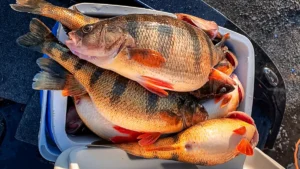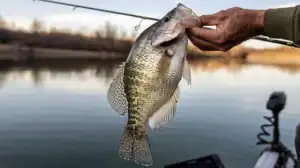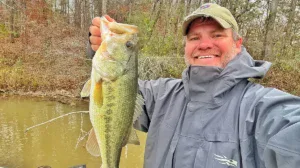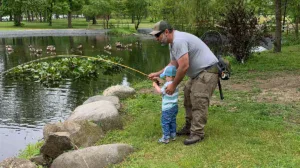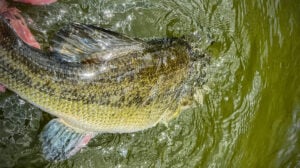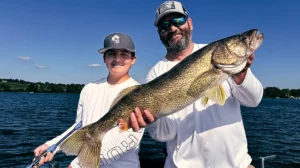Lipless crankbaits are a great remedy for tough wintertime bass fishing. With these ultra-lifelike baitfish imitations accounting for a large percentage of winter’s biggest bass, the secret is out—they’re some legit, fish-catching lures. There are, however, a few caveats to be mindful of before tying one on in search of a coldwater giant.
Alabama fishing guide Tim Chandler relies on the effectiveness of lipless crankbaits throughout much of the winter. Regardless of his clients’ skill levels or the conditions, he won’t leave the boat ramp without them.
According to him, understanding a few key concepts will dramatically increase your success with these time-tested bass lures.
You want a wiggle, not a wobble
It may sound like a tongue twister, but it’s actually an important concept to understand in regards to wintertime lipless crankbait fishing. Plainly stated, both the bass and their forage are downright cold right now. The bass aren’t likely to travel great distances to feed and their prey—in this case, baitfish—are simply fighting for their survival. To increase your catch, it’s important to make your presentation blend in with such widespread inactivity.
“When the water reaches the low 40-degree mark, baitfish activity almost reaches a standstill,” Chandler said. “They won’t move very much and when they do, they’re going to move slowly and swim in a very subtle manner, just barely moving from side-to-side. A lipless crankbait is a near-perfect imitation of this behavior because it has an extremely tight wiggle as opposed to the wider wobble of a crankbait.”
In addition to emulating lethargic bait behavior, a lipless crankbait’s delicate swimming action also emits a faint flash of color with every movement. In a bass’ eyes, this color flash is indicative of an injured shad and an easy meal.
“A lot of shad die when the water turns frigid,” Chandler said. “As they die, they flutter to the bottom and the bass take advantage of it. When you make your lipless crankbait move, the bass easily mistake its color flashes for a dying shad, which is why it’s so incredibly effective this time of year.”
They’re not alone
It’s always important to cover water efficiently when developing a productive bass fishing pattern but efficiency plays a paramount role when finding winter bass. Lipless crankbaits give you the ability to fish quickly in hopes of finding a giant group of fish.
“Lipless crankbaits allow you to do two very important things,” Chandler said. “You can cast them a mile and you can retrieve them quickly. When you don’t have to spend much time between casts, you’ll be amazed at the amount of water you can cover in a day. When you catch a bass in the winter, there’s a great chance there are more with it. Lipless crankbaits may not catch every bass in the school, but they’re outstanding at triggering the most dominant or active ones.”
The right size makes all the difference
An honest error in your lipless crankbait size selection can be the difference between a big goose egg and a day to remember. Chandler considers two primary factors when deciding which XCalibur Rattle Bait to use.
Sizing ’em up: Chandler uses this simple system to match his lipless crankbait size with his target water depth.
- Xr25: 2 feet or less
- Xr50: 2 to 6 feet
- Xr75: 4 to 10 feet
“It’s an old cliché in the fishing world, but it’s true—you have to match the hatch,” Chandler said. “You don’t want to throw a huge lure when most of the bass’ food is two inches long because it just doesn’t look natural. If you don’t know the forage size, an Xr50 is a great middle ground to begin with. If you start catching fish over three pounds or notice bigger forage, bump it up to the larger Xr75.”
Chandler also carefully considers the depth at which he’ll be fishing. He’s developed a system that makes his selection process very easy.
“When I’m fishing in skinny water, I’ll use a smaller size than I would if I were targeting deeper water,” Chandler said. “You can keep it higher in the water column without it digging bottom constantly. As I go deeper, I’ll use a larger size because it will sink faster and allow me to spend more time in the most productive strike zones.”
Prime targets
To catch more bass with a lipless crankbait, it’s imperative to target high-percentage areas. These four types of areas have consistently produced giant winter bass throughout Chandler’s career.
- Submerged vegetation— “Contrary to popular belief, depth and location is largely secondary when it comes to this type of pattern. You can catch ‘em anywhere from inches to 12 feet deep, but it’s all about finding the right kind of grass. You want to feel your lure stick to the grass and come out cleanly when you pull on it—you don’t want a bunch of salad. The healthier the grass, the easier your lure will come through it and the better your chances are of finding a significant school of bass. If you can get your lipless crankbait back without wads of dead grass hanging from it, you’re likely to get bit, regardless of the location or depth.”
- Stumps—“Even though the water might still be cold, the days are getting longer and giving the sun more time to warm the water,” Chandler said. “When the bass slowly begin to move shallow later in the winter, they’re going to relate to wood, which makes stumps an outstanding option. Try to find stump flats located within 100 yards of deep water and remember, ‘deep’ doesn’t always mean 20 or 30 feet—sometimes a four or five-foot depression is enough.”
- Hard bottom areas—“Productive hard bottom areas void of additional cover can certainly hold fish right now, but nearby vegetation and wood cover is always a plus,” Chandler said. “When you bring your lure across a hard bottom spot at a moderate pace, you can feel the hooks grabbing the hard bottom. When you pull it up to break it free, the bass will react to the sudden movement and totally crush it.”
- Points—“Points are great spots to fish throughout the entire year,” Chandler said. “I look for long, tapering points that dump off into creek or river channels because they give bass the security of deeper water and abundant feeding opportunities. Try to find a few of these points that face up-current if your fishery has current. The bass face into the current and use these points as ambush spots.”
Retrieves to consider
The tight wiggle and color flash of a lipless crankbait is enough to catch a few bass on a standard, cast-and-reel retrieve, but it doesn’t unleash its full potential. The next time you hit the water with a lipless crankbait, Chandler suggests trying these retrieves.
- Yoyo it—“Very rarely do I just cast and wind my lipless crankbaits,” Chandler said. “At the beginning of the day when I’m still trying to figure out the fish, I’m going to throw it out there and let it sink all the way to the bottom. I’ll start with a steady retrieve but right when it collides with something, I’m going to pull the bait up and let it fall down—just like a yoyo. It’s important to let it fall on a tight line because they’ll eat it on the fall a lot and these winter bites are often extremely subtle.”
- Crawl it—“When the action is slow, it’s not uncommon for me to fish a lipless crank just like I would a Texas rig,” Chandler said. “It’s almost like the yoyo retrieve, except slower. When you drag it across the bottom, the hooks are ticking nearby cover and when you jerk it free, you accomplish two things—you clear the hooks of any trash and spur some massive reaction strikes in the process.”
- Burn it—“After a three or four day warming trend, I’ll reel a lipless crankbait as fast as I possibly can with a 7.3:1 reel,” Chandler said. “The warmer weather really ignites a bass’ metabolism, so they become much more apt to chase a quickly moving target. When the conditions line up, find some flats in about four feet of water, burn it and hold on.”
- Dead stick it—“This retrieve works best when the water gets below about 42 degrees,” Chandler said. “Make a long cast and let it sit on the bottom for five or six seconds before moving it slowly—it looks just like a dying shad. It’s hard to force yourself to fish like that, but they’ll eat it just like a jig. As soon as you feel the ‘thump’, it’s time to set the hook.”
Don’t be afraid of cover
If you’re not careful, it’s easy to lose your lipless crankbait when fishing around cover. While standard crankbaits are designed with a bill to aid in cover deflection, a lipless crankbait is different. To achieve its trademark tight wiggle, you won’t find a bill. The result is a fish-catching machine that’s prone to hang-ups.
Let ’em eat it: Because he uses braided line, Chandler likes a softer rod to facilitate a better load, giving the bass more time to eat his lure. He prefers a 7-foot, 3-inch medium-heavy Falcon Cara T7 Reaction Casting Rod.
There’s good news, however. Chandler believes the absence of a bill can be counteracted by four simple tips.
- Use braided line—“Regardless of where I am, I always throw a lipless crankbait on 30-pound Sunline SX1 Braided Line,” Chandler said. “I don’t have much success on a lipless crankbait in very clear water, so I don’t think the thicker line matters to the fish—I’ve never seen it make a difference in my experience. Braid will help let you know the second your lure touches cover, giving you ample time to pull it upward and away from any snags. It’s all boils down to your preference and confidence, but braided line has always been outstanding for me.”
- Speed your retrieve—“When you’re around wood cover, such as stumps, a slow retrieve isn’t the best,” Chandler said. “It gives the lure plenty of time to roll over the wood instead of glancing off to the side. You can get away with slow-rolling a squarebill crankbait over wood due to its buoyancy, but not a lipless crankbait.”
- Keep your rod tip high—“By keeping your rod tip high, you’re allowing the nose of the lure to deflect the hooks away from the cover,” Chandler said. “This keeps the bait a little higher in the water column and promotes an upward deflection instead of a downward, snag-inducing deflection.”
- Modify your hooks—“When you’re fishing grass and constantly jerking the lipless crankbait free, the lure will almost flip end-over-end which causes the back hook to grab the line and become fouled,” Chandler said. “It usually gets hooked on the same point of the treble each time, so I take a pair of wire cutters and cut that point away at the bend. It doesn’t hurt your hookup ratio and it totally eliminates an age-old problem.”
If you’re getting tired of braving the cold winter weather without good results, take a day to fish with a lipless crankbait. If you can learn where to throw it, how to work it and how to unleash its full potential, you’ll enjoy more and bigger bass this winter.
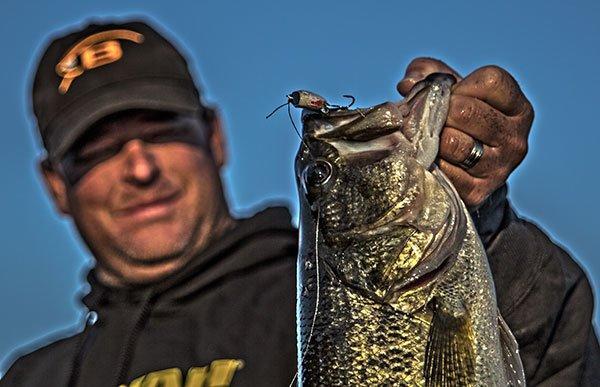


![[VIDEO] Greg Hackney’s Formula for Post-Spawn Bass Success](https://www.wired2fish.com/wp-content/uploads/2025/05/Hackney_Post-Spawn_Bass-300x169.webp)
![[VIDEO] Scanlon’s Guide for Stained Water Spawning Bass](https://www.wired2fish.com/wp-content/uploads/2025/05/scanlon-jig-300x169.webp)
![[VIDEO] Seth Feider’s Prespawn Jig Pattern Explained](https://www.wired2fish.com/wp-content/uploads/2025/04/prespawn-jig-300x169.webp)
